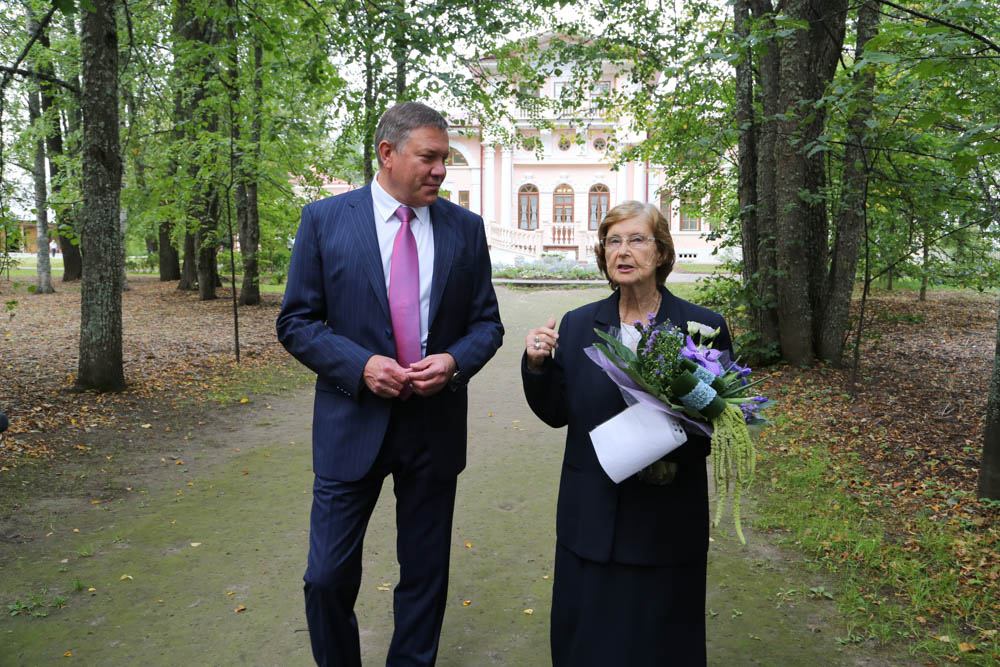The meeting took place at Bryanchaninovs' country estate, a unique monument of history and culture of the Federal value.
In 2009 the Bryanchaninovs' country estate was restored in the village of Pokrovskoye (Gryazovets District) with funds provided by the Oblast budget. The Most Holy Patriarch of Moscow and all Russia, the primate of the Russian Orthodox Church Alexius II gave a blessing to it.
Holy Hierarch St. Ignaty Bryanchaninov was born into the Bryanchaninov family, a family of long-standing nobility on February 5, 1807 in the village of Pokrovskoye. Holy Hierarch Ignaty earnestly saw as his most important tasks apostolic service to the flock, bringing peace and strengthening and spreading Holy Orthodoxy. Ignaty made zealous efforts to establish liturgical life and normalize relations between clergy and laity. The Holy Hierarch took care to improve the daily life of the clergy, to raise its educational level, and to improve their interrelations to a level consistent with their spiritual calling.
Even in our days, there is continued interest in Bishop Ignaty himself and in his immortal writings. Holy Hierarch Ignaty Bryanchaninov is the best spiritual director, the best example of how in the whirlpool of life one can preserve faith in Christ. The Bryanchaninovs' country estate attracts the ever-increasing number of Orthodox pilgrims and tourists fr om all parts of Russia.
The history of Pokrovskoye settlement is connected with the Bryanchaninov family that started with the boyarin Mikhail Brenko, killed in the Battle of Kulikovo. The Bryanchaninovs' lands in Vologda, Gryazovets and Kadnikov districts were first mentioned in a chronicle of the 17th century. Probably Pokrovskoye was granted to the Bryanchaninovs for their participation in the volunteer corps of 1611-1612.
In 1803 the settlement of Pokrovskoye was inherited by Alexander Semyonovich Bryanchaninov, father of Ignaty. Being a person of great enterprise, the owner decided to construct a new manor next to the rural churchyard wh ere all the deceased members of the family had been buried. The construction was completed in 1812.
It is believed that the house was designed by a self-taught person Alexander Sapozhnikov. Though some researchers consider the distinct, graceful and strict proportions of the building reveal many points in common with the Moscow school of architecture presented by Matvey Kazakov. At the same time other scholars think it has much in common with architectural works by another well-known master - Nikolay Lvov.
Its territory making up 1965 hectares in 1840-1850s, the country estate in Pokrovskoye grew and thrived. It focused on weaving, gilding and carving. The country estate also boasted small factories, a kennel with more than 200 dogs, and a menagerie for hunting.
In 1918 Vladimir and Sophia Bryanchaninovs, the last owners of the country estate emigrated to Czechoslovakia having left all their property. Later they moved to France and their children left for Australia in 1945.
The family necropolis is located to the left of church. Vladimir Bryanchaninov, the last owner of the manor passed away in France in 1963. His ashes were transported to Russia by his granddaughter Tatyana Watson and buried in Pokrovskoye. Ms. Watson who lives in Australia now comes to Pokrovskoye very often. Those who ever met Tatyana Watson mention her affectionate love to the Native land.
During the meeting Oleg Kuvshinnikov thanked Ms Watson for her work to preserve the memory of the ancestors. Tatyana Watson was awarded a state award of the Vologda Region - the Medal "For merit to the Vologda Region" for her tangible contribution into the restoration of her ancestors’ mansion.
Теги: en




